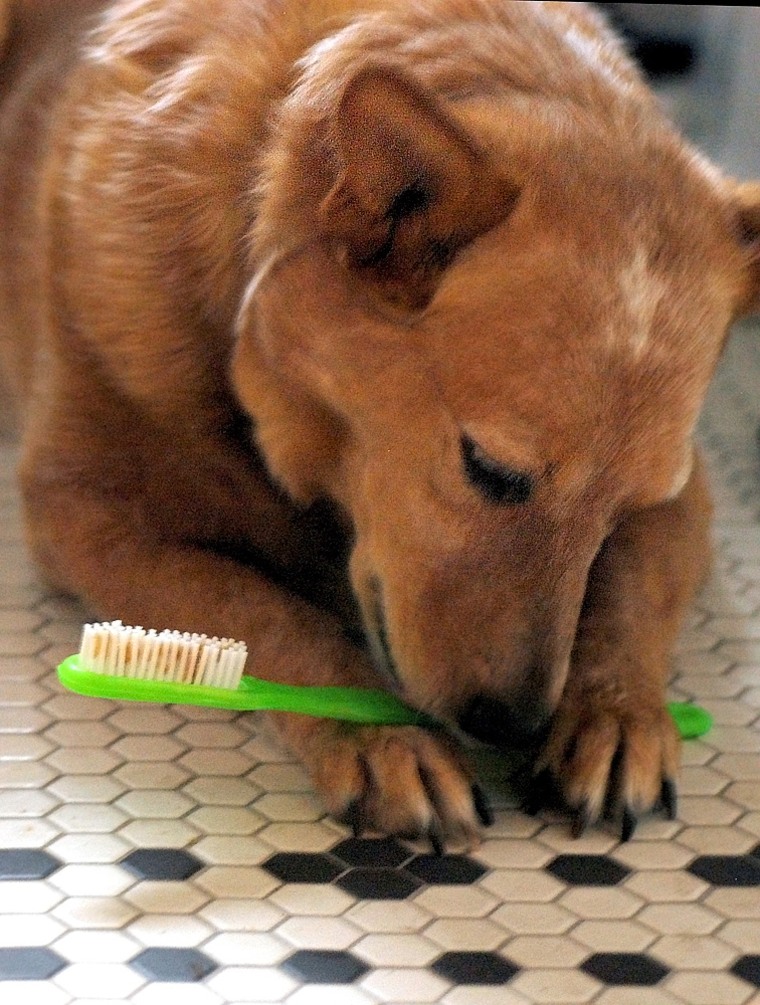When was the last time you brushed your dog's or cat’s teeth? Can’t remember? Counting on dry kibble and a daily hard biscuit to keep his fangs clean and breath sweet?
Well think about this: If you ate a Milk Bone every day but didn’t brush your teeth, probably not even your dog would want to come near you.
Daily brushing is the single most important thing you can do to keep Buster's and Boots’ breath fresh and teeth tartar-free.
More important, good dental hygiene contributes to your pet’s overall health and can even increase his life span.
“I usually tell people that if they aren’t going to take care of their pets’ teeth, the decreased life span is at least two years,” says Jan Bellows, a veterinary dentist who operates All Pets Dental in Weston, Fla.
That’s because the bacteria that build up beneath the gum line enter the blood stream and can settle in the heart valves, kidneys and liver. That’s not great for any animal, but in an older pet or one with a compromised immune system, it’s really bad news.
Beyond brushing
The good news is that in addition to brushing, there are lots of new ways to help keep your pet’s mouth healthy. Dental diets, treats impregnated with plaque-busting substances, and tartar-control rinses, sprays, gels and wipes can all take a bite out of periodontal disease.
If you’ve been feeding dry food because it’s supposed to help keep teeth clean, you’re on the right track.
“There’s some evidence that dry food is not as sticky as moist food, so if dogs would actually chew it, then there’s a benefit not only in having sort of a squeegee cleansing effect, but also from having food that’s not very sticky to begin with,” says Kenneth Lyon, a veterinary dentist at Arizona Veterinary Specialists in Gilbert, Az.
The problem is that most pets wolf their food instead of chewing it thoroughly before swallowing. Enter dental diets. There are two types on the market.
“Hill’s TD mechanically scrapes off the plaque by staying in contact with the tooth a lot longer than regular kibble,” Bellows says. “With regular kibble, they bite it and it crumbles. With TD, both in dogs and cats, it stays in contact with the tooth longer so it squeegees off the plaque.”
The other dental diets contain sodium hexametaphosphate (HMP), which works by slowing the rate at which plaque hardens into tartar, making it more easily removed from the surface of the tooth.
Prefer to stick with what you’re feeding now? Ask your veterinarian about gels or rinses that can prevent a plaque attack on teeth.
Veterinary dentist Brook Niemiec of Southern California Veterinary Dental Specialties in San Diego likes a new product called Oravet. “It’s a waxy barrier that’s applied by the veterinarian during a cleaning and then weekly by owners, who simply spread the gel on gums with their fingers or an applicator stick. It stops plaque from forming on teeth,” he says.
Sprays, rinses and wipes that contain chlorhexidine or zinc ascorbate cysteine (ZAC) compounds are also available from your veterinarian. Chlorhexidine products contain enzymes that dissolve plaque and help reduce bacteria, and the ZAC compounds encourage collagen production, which helps stimulate the repair of gum tissue.
Last but not least are a variety of tartar-control chews coated with chlorhexidine, HMP or enzymes to fight plaque.
None of these foods, treats, or other products takes the place of brushing, but they’re better than nothing.
Flossing? Your dog can do that for himself by chewing on a rope or sheepskin toy or dental Kong with grooves that help scrape teeth clean. Fill the grooves with doggie toothpaste for extra cleaning power.
Treating gum disease
If your dog or cat has developed periodontal disease — and most have by 2 to 4 years of age — a veterinary cleaning under anesthesia combined with periodontal disease treatments can help keep it from progressing.
Your veterinarian may recommend placing chips or gels that contain antibiotics beneath the gum line. “These help arrest the progression of periodontal disease and it looks like they will restore some of the lost bone when the sockets and gums recede,” Lyon says.
Under development, he adds, is a vaccine for periodontal disease in dogs that would be made from the most common oral pathogens and designed to reduce the effect of those pathogens. “It would be great if it works,” he says.
Kim Campbell Thornton is an award-winning author who has written many articles and more than a dozen books about dogs and cats. She belongs to the Dog Writers Association of America and is past president of the Cat Writers Association. She shares her home in California with three Cavalier King Charles Spaniels and one African ringneck parakeet.
